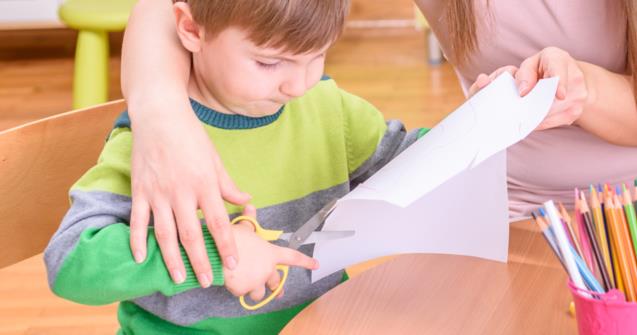
A trick for learning to hold scissors the right way
Children can hold their scissors backwards, with two hands, use their body to direct them... They tend to test a variety of different techniques, all except the right one! Why do children have so much difficulty holding scissors the right way when they are first introduced to this tool? In fact, it's most likely because scissors aren't symmetrical and therefore offer many possibilities in terms of spatial organization. The fact that a child's hand isn't symmetrical either makes the challenge even greater.
To hold scissors the right way, a child must:
- select the right hand;
- decide which part of the scissors will be on top;
- decide which fingers will be in the small loop, if the scissors have two loops of different dimensions;
- determine the scissors' direction (towards his/her body or towards the room).
Although it may seem obvious to us, as adults, that the correct grip leads to more efficient cutting, young children who are beginning to learn how to use scissors have difficulty feeling the correct scissor grip in their hands. Establishing a relationship between this grip and the quality of their cutting activities is therefore impossible.
Between the ages of 2 and 6 years old, children will experiment with different scissor grips depending on the development of their fine motor skills and the types of scissors they have access to. This testing phase is considered part of normal motor skills development.
All children will go through a testing phase during which they will cut without having a specific goal in mind, with no interest in following a line or creating something. Once a child expresses an interest in more elaborate cutting activities, it may be interesting to help him/her transition to a mature scissor grip, if he/she hasn't already developed it. A good trick must help a child visualize the correct way to place his/her fingers and be easy to remember. Of course, a good trick must also be fun.
Here is my favorite trick: the SCHOOL BUS TRICK!
The story is simple. With a drawing, introduce children to the following analogy: the scissors represent a school bus, the thumb is the driver who must sit in the smaller loop, and the other fingers are the passengers who sit in the larger loop (the seats).
Is your index finger out of the loop?
You may have learned to keep your index finger out of the loop to guide the scissors or developed this habit. This is in fact an excellent method! Nonetheless, it is somewhat difficult to teach to young children and hands/fingers that aren't completely dissociated yet.
However, if you feel the children you work with are ready, you may try to teach them to keep their index finger out of the loop. For example, you may tell them that the index finger refused to board the bus.
Josiane Caron Santha, Occupational therapist

 Home
Home Theme activities
Theme activities
 Babies and toddlers
Babies and toddlers
 Arts and crafts
Arts and crafts
 Science
Science
 Creative recipes
Creative recipes
 Tips and tricks
Tips and tricks
 Special needs
Special needs
 Extra activities
Extra activities
 Educ-TV
Educ-TV
 Newsletter
Newsletter  Online store
Online store Educatall club
Educatall club

